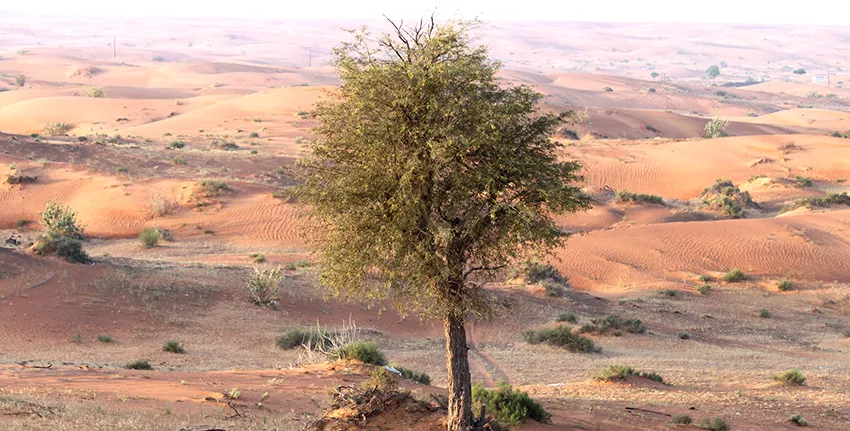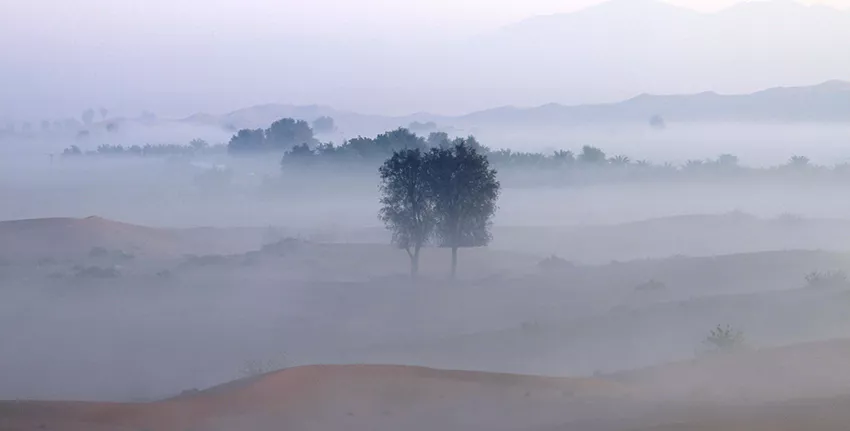Scientists see untapped potential in UAE’s national tree
26 June 2018
Ghaf (Prosopis cineraria), a flowering tree, holds great promise for combating desertification and improving soil fertility in arid environments thanks to its unique qualities, long-term research by the International Center for Biosaline Agriculture (ICBA) suggests.
Considered the UAE’s national tree, Ghaf has multiple uses, including as a key element of agroforestry systems in arid and semi-arid regions. In agroforestry, trees are managed together with crops and livestock, which helps to increase social, economic and environmental benefits for farmers and other land users. Ghaf’s deep and broad root system means that it can grow in extremely harsh conditions and help fight desertification. What is more, its ability to fix nitrogen improves soil fertility naturally.
According to Dr. Muhammad Shahid, a geneticist and curator of ICBA’s gene bank: “The tree helps in the reclamation of areas lost to desertification. It is also highly salt-tolerant. So you can grow it in salt-affected soils, of which there are a lot in the UAE and other countries of the Middle East. We call them marginal soils.”
Ghaf can play an important role in the fight against desertification as it improves the soil, which, in turn, makes it possible to cultivate different food and fodder crops, including barley, cowpea, sorghum and pearl millet.
However, the tree is under threat due to global warming and an increasing number of camels, which overgraze it. Another problem is that the country’s population boom, among other things, led to groundwater overuse, resulting in dropping water tables beyond the reach of the tree roots. Pollution of both air and water also contributed to a decline in the number of trees in the UAE.
In response, government, non-government and private organizations have been taking measures to secure the future of the tree. Goumbook, a UAE-based social enterprise, launched, for example, the “Give a Ghaf” tree planting program as a not-for-profit initiative in 2010 to raise awareness about the problem. As a result, thousands of seeds have been planted at its nursery since then.
ICBA has also conducted long-term research on the benefits and uses of the tree. The center completed the first-of-its-kind study of 82 trees growing in 1 sq. km. during 2001 and 2002. The study detailed uses ranging from shelter to forage to wood and fuel.
To see the diversity within the species, 25 different traits of the tree were studied in detail. Data on different characteristics of tree crown, leave, inflorescence, pod and seed were collected during the research. The analysis of the data showed a big variation among Ghaf trees even within a small area. Commenting on the research, Dr. Muhammad Shahid explains: “Some plants have a big crown, so you can get more leaves from them, and some trees produce more pods, which can be used as forage for animals.”
“Ghaf is the most important tree of the UAE. It provides shelter to a lot of wildlife, including different birds and animals, and people use the leaves and pods as forage for their livestock,” Dr. Muhammad Shahid adds.
A separate study in 2016-2017 also confirmed the tree’s survival characteristics. Scientists conducted experiments with the seedlings of Ghaf, neem and Ziziphus to test Cocoon technology of Land Life Company in desert conditions. Preliminary results showed that Ghaf had much better performance and higher rate of survival and growth than the other two tree species.
Ghaf’s leaves include 14 percent of crude protein, 20 percent of crude fiber and 18 percent of calcium, which make it highly nutritional for animals such as goats, sheep, camels and donkeys. Bees also use nectar from the tree’s flowers, producing honey deemed a delicacy across the country. Its wood can be used in the construction of houses and boats, and even as fuel.
Before the oil boom, residents of the region would eat the young tender Ghaf leaves and pods as salad or add them to rice as a supplement. It was also used to cure different ailments, including cataracts, dysentery, dyspepsia and toothaches.
As part of this research, ICBA has distributed seeds of the tree to scientists across the Middle East for studies on its tolerance to saline and arid conditions. “Many good elements can come out of this tree. It is beneficial to the UAE’s environment, as well as to the environments of Saudi Arabia’s eastern region, Kuwait, Qatar and Bahrain,” Dr. Muhammad Shahid concludes.
And that is probably why the founding father of the UAE, the late Sheikh Zayed bin Sultan Al Nahyan, emphasized the importance of preserving Ghaf and encouraged its plantation along highways and in the open desert.












